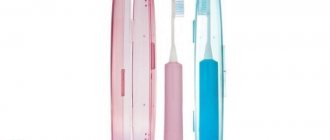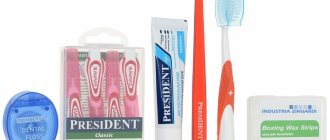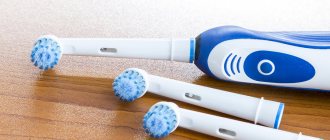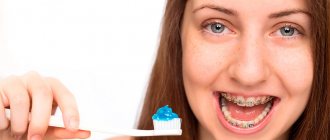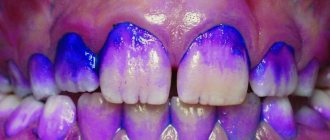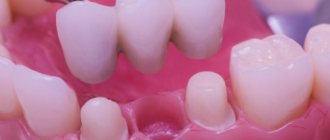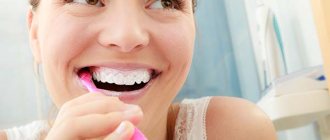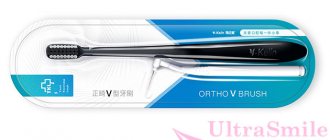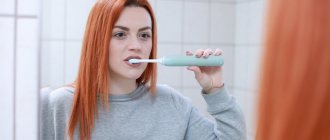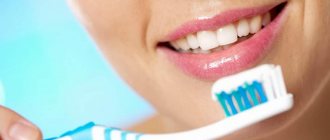Today, more and more people are deciding to switch from using regular toothbrushes to electric ones. This is a completely rational solution, which is aimed not only at making cleaning easier, but also at increasing the effect of using the brush. However, most people mistakenly believe that brushing teeth is a very simple procedure that does not have any nuances. This is not true, and today we want to figure out how to use an electric toothbrush so that the result of its use is positive and obvious.
Of course, one of the most important aspects of maintaining oral hygiene is systematically brushing your teeth 2 times a day. However, these are not all the subtleties that you should know about. And below we will try to analyze step by step the most important aspects and nuances that can teach you how to use an electric toothbrush correctly.
Seventh step
When the teeth cleaning procedure is completed and the oral cavity is clean, you need to take care of the electric toothbrush itself. Most brushes are waterproof and invulnerable to moisture, so the device can be safely rinsed under running water. This can be done in just a few seconds.
After cleaning the brush, it must be placed in a vertical position. This can be done using a regular glass. The glass, of course, must be dry and clean.
Contraindications
Almost all contraindications to using an electric brush are relative or temporary. The use of the device should be discontinued in the following clinical situations :
- after surgery in the dentofacial area;
- stomatitis;
- tooth mobility grade 3;
- after oncological surgery;
- hypertrophic gingivitis.
Note! Only after eliminating such pathologies or abnormalities can you begin to use an electric device for brushing your teeth.
If you experience unpleasant sensations while using the brush, it is better to abandon them completely.
Ninth step
Check if the toothbrush is dry, and if the answer to this question is yes, place it on a special stand. If the brush's charge is low, it is recommended to place it in the charging station in a timely manner so that the device is fully ready for use by the next time you brush your teeth. If the brush is set to recharge, we recommend that you monitor the charging process by turning off the gadget in a timely manner, because excessive charging installation time will not benefit the brush.
How to choose pasta?
It is best to use the toothpaste recommended by your doctor. People with healthy teeth can use universal hygienic toothpastes . They have an antiseptic effect, whiten and freshen breath.
For the purpose of prevention, sometimes it is necessary to switch to pastes to prevent caries and periodontal lesions . They contain fluorine and calcium compounds.
Important! You need to be as careful as possible with whitening pastes, since they contain chemical oxidizing agents or abrasive particles.
Such products are contraindicated for those who have increased enamel sensitivity.
Children are advised to use low fluoride toothpastes . In the period from 6 to 13 years, it is necessary to give preference to products with a minimal amount of abrasive substances and a high calcium content. Upon reaching 13 years of age, you can switch to adult pastes.
Brushes from different manufacturers
As you know, on the modern market there is a fairly wide range of different manufacturers involved in the creation and sale of electric toothbrushes. Perhaps the most popular of them are the following companies:
- Braun Oral-B;
- Philips;
- Colgate.
They all produce brushes with different parameters and operating modes, which is why each device may have its own nuances of use. Fortunately, today it is not so difficult to find official video tutorials on how to use an electric toothbrush from a particular manufacturer.
However, as regards the actual procedure of brushing teeth, all manufacturers agree that the option of brushing teeth by sectors (dividing the oral cavity into four conventional parts) is ideal.
What characteristics of an electric brush need to be taken into account?
Before purchasing a brush, you should consult with your dentist, since the condition of your teeth and gums determines the requirements for the properties of the model you are using.
Bristle
The bristles should be made of synthetic materials, such as nylon. Natural fibers may have hollow parts where bacteria can accumulate over time. The stiffness of the bristles is selected by the doctor individually. Without his recommendation, you should not use brushes with hard bristles. Soft and very soft bristles are recommended for patients with sensitive enamel and gum problems, as well as for children. For the rest, medium-hard bristles are suitable. Particular attention should be paid to the tips of the villi. For more delicate care they are made rounded. Pointed bristles can scratch tooth enamel.
Battery or batteries
Battery-powered electric brushes lose power as their charge decreases. Therefore, the effectiveness of this tool may gradually decrease. In addition, when buying it, the user also acquires the need to constantly spend money on batteries. The battery allows you to control the charge level before each cleaning and does not require additional costs.
Handle and weight
It is better to choose a curved handle made of non-slip materials. The weight of the device should not strain your hand during the 3-5 minutes spent cleaning the entire oral cavity. It is especially worth paying attention to these characteristics when choosing a brush for children.
Number of nozzles
Several interchangeable cleaning heads allow you to use one electric brush for all family members. For example, buying a set of Glister™ Smart Sonic electric toothbrush and spare brush heads is cheaper than purchasing several separate accessories for the whole family.
Noise
The vibrations of electric brushes do not produce loud sounds. But those with sensitive hearing may experience discomfort from even a slight buzzing sound. In this case, you should opt for silent ultrasonic models.
Additional functions
The latest models of electric toothbrushes are equipped with features that allow you to improve the process of brushing your teeth. The most common among them:
- a timer that beeps when it is time to move to the next area in the oral cavity;
- a pressure sensor that warns when to reduce the pressure on the cleaning head;
- compatibility with a mobile application that allows you to evaluate the result of the procedure and configure the operating mode of the device.
This application was created for the Glister™ Smart Sonic electric brush. It:
- offers one of five operating modes depending on the condition of the teeth and eating habits;
- detects cleaning time;
- shows which area needs special attention.
How to properly care for your electric toothbrush
Finally, it is necessary to consider some more very important nuances for caring for an electric toothbrush. If you want your device to serve you as long as possible without any problems, we recommend that you listen to these tips.
The first of these tips is the rules for storing brushes outside the home, that is, when traveling and travelling. Often, EZHs are used directly for greater convenience when traveling, but unsanitary conditions are typical for trains and other vehicles in which we have to brush our teeth. Therefore, it is recommended to store electric brushes in such conditions exclusively in special cases and boxes.
Another nuance that you should be aware of concerns the use of special disinfectants for electric toothbrushes. As we have already noted, brushes must be cleaned and rinsed after use. However, if you want to be sure that your toothbrush is as disinfected as possible, it is recommended to use a device such as a disinfector or sterilizer.
These are special devices in which brushes are dried and disinfected using ultraviolet light, thereby acquiring the most appropriate appearance for further use. Some brushes are supplied with such a device, but such a set can be seen in more expensive device models. Budget electric brushes require the purchase of an additional sterilizer.
By following all these rules, you will very quickly learn how to use an electric toothbrush, as well as how to properly care for it.
Rules for cleaning the tooth surface
When using electric models, you can start brushing your teeth from both the lower and upper jaws. It is better if the cleansing process takes you at least 2-3 minutes. In this case, you need to linger on one tooth for 2-3 seconds. During the procedure, do not make any additional movements with your hand, just smoothly move the brush from one tooth to another. The device is already programmed to perform certain rotational and translational movements.
When cleaning the outer surface of the teeth , the bristles should adhere to the enamel at right angles. Movements and pulsations should be as smooth as possible. The external cleaning procedure covers the entire surface of the tooth, right down to the gums.
Caring for the back surface of teeth - just as in the previous case, the brush should move smoothly from one tooth to another. For greater convenience, the device is rotated vertically. It is important that the bristles reach the gums without damaging them. The inside of the teeth is hidden from view, so maximum attention must be paid to it.
Cleaning the chewing surface - Chewing teeth require careful attention, so when brushing, you can use light pressure on the brush. The procedure time for this part also increases to 3-4 seconds. Gradually you will learn to control the pressure.
Cleaning gums - When it comes to cleaning gums, some models have a special attachment designed for this purpose. If there is no attachment, then you can massage soft tissues by turning off the device.
The advantages of using the model are the high quality of enamel cleaning, as well as ease of operation. In the absence of contraindications, such devices are recommended even for children. Correct use of the device facilitates the treatment of certain oral diseases.
Brush position and pressure
Ultrasonic teeth cleaning is successfully carried out in a dental clinic. This professional procedure is performed using modern equipment. The effect is immediately noticeable. If you maintain it at home with an electric brush, then beautiful and white teeth are guaranteed. When cleaning, no special pressure is required to avoid damaging the enamel. Even devices with low power make 4 thousand revolutions in 60 seconds. You just need to choose the appropriate mode of operation of the device: from gentle to maximum.
New devices are usually equipped with sensors that monitor the degree of pressure. The design also includes a timer. It shows the time it takes to clean one segment. Smart brushes are convenient to use. Their head is designed taking into account the anatomical features of the dentofacial apparatus.
Applying the brush to the crowns along the line of the gum tissue, the head should be positioned at a 45-degree angle. In this case, the villi will touch the surface of the units and gum tissue. This position of the device will make cleaning more effective. The pressure on the brush should be minimal, since the vibration of the device creates additional pressure.
What are the advantages of using
Cleaning with an electric special brush has a number of undeniable advantages:
- Quickly and efficiently removes various stains from enamel. Scientists conducted an experiment that proved that an electric brush removes plaque twice as well as a classic accessory. During the procedure, the user only needs to correctly guide the head with moving bristles. Dentists confirm that the use of such a device can prevent many dental diseases. The condition of the gums improves and plaque is quickly and effectively removed.
- The device cleans teeth effectively. The nozzle completely covers the tooth and cleans even hard-to-reach areas.
- Children love to brush their teeth with children's electric brushes. Using such a device, you will quickly teach your child the correct procedure.
- It will take about two to three minutes. When cleaning is performed using a standard accessory, part of the tooth surface is left unattended. The electric device is capable of completely covering the tooth. Some models have a built-in timer that will help you determine when it's time to move on to the next section.
According to user reviews, it is worth paying attention to various technical characteristics. It would also be a good idea to have a preliminary consultation with your doctor.
How to properly brush children's teeth?
A child can be introduced to an electric toothbrush from the age of 3 years. But up to 7, you should guide the brush and not let go of it while brushing. During this period, it is important to teach the child to spit the toothpaste and rinse his mouth.
The technique of brushing teeth in adults and children is no different - the only difference is that parents help children brush their teeth. Sit in a way that is comfortable for both of you: sit the child on your lap or stand behind him in front of the mirror. If your brush does not have a built-in two-minute timer, use a special application that will motivate and captivate the child (for example, some applications gradually open a picture of cartoon characters while brushing teeth).
Philips Sonicare electric brushes: advantages and disadvantages
Philips products are recognized as reliable and high quality. In this case, we are talking not only about toothbrushes, but also about other equipment. Oral cleaning devices manufactured under the Philips Sonicare brand are no exception. Experts name the following advantages:
- allow you to quickly cleanse the oral cavity of germs and food debris;
- help eliminate plaque and prevent its formation;
- suitable for almost everyone, as they have no contraindications;
- equipped with many functions, sensors and indicators;
- Compatible with various attachments.
The only disadvantage of Philips Sonicare electric toothbrushes is their high price compared to other models. The attachments are also expensive. However, there is an opportunity to save money: the whole family can use one device, just each member must have their own nozzle. In addition, it offers a large selection of toothbrushes, among which you can find an affordable model.
Should I floss?
The question is controversial. The brush removes only 60% of the dirt: it cannot reach the interdental spaces, and a lot of excess remains in them. Therefore, a tool for cleaning interdental spaces is definitely needed.
But does it have to be dental floss? Some experts believe the method is outdated, the evidence for its effectiveness is inconclusive, and flossing can damage gums and teeth if used incorrectly. Interdental brushes can be used instead of dental floss.
or
water irrigator
.
American dentists still recommend dental floss. You should floss once a day, before or after brushing your teeth. Keep in mind that if you're just starting to floss, it may be uncomfortable in the first week and your gums may bleed. This happens because you injure the overgrown gum with the floss. With proper oral hygiene, this tissue is absent, so the discomfort will soon subside.
Irrigators for cleaning
An irrigator is a device that washes away plaque with water pressure and washes away food debris from the interdental crevices. It can be called a gentle alternative to dental floss.
The irrigator is indispensable when caring for teeth with braces or implants, because it carefully cleans the most inaccessible places and does not injure the tissue. The jet pressure is adjustable, and the device can also be used to hydromassage the gums to stimulate blood circulation.
In addition, you can fill the irrigator not with water, but with a composition for rinsing the mouth.
A stream of water released under pressure gently cleans teeth without injuring soft gum tissue.
What should be in toothpaste?
The main thing is fluorides
, which reduce the risk of caries and strengthen tooth enamel. The paste may also contain active ingredients to reduce tooth sensitivity, against germs and for whitening. But it is not they that cause the most controversy, but the abrasive - particles that physically help remove plaque and stains from teeth and polish the enamel.
Abrasive particles should not be too large, hard or sharp, so as not to scratch teeth and wear out dentin and enamel. Sand, for example, or crushed cuttlefish bones, which were used in pastes before the 1900s, are poor abrasives. Therefore, now there is a standard for abrasiveness - < 250 RDA
(relative dentin abrasivity). Sometimes it is recommended to choose toothpastes with a lower RDA because they are supposedly safer and wear less on teeth. In fact, there is no evidence for this recommendation. For example, the American Dental Association (ADA), which developed the RDA scale, advises choosing any paste with an abrasiveness below 250 RDA. Actually, it’s difficult to find another one on the market now.
